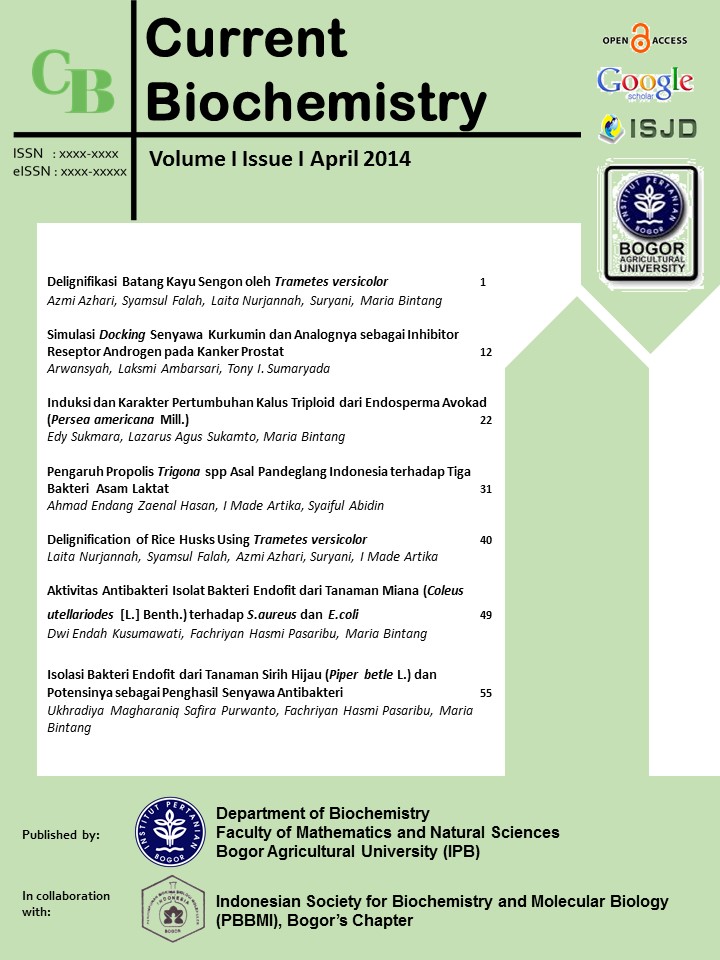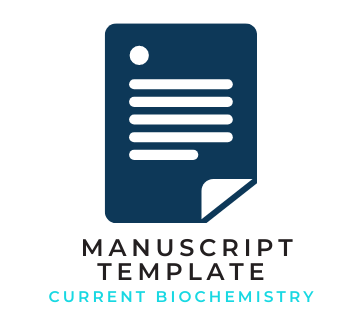Isolation and Molecular Cloning of Cellulase Gene from Bovine Rumen Bacteria
Abstract
Cellulases are the enzymes that hydrolyze cellulosic biomass and are produced by the microorganisms that grow over cellulosic matters. The objective of this research was to isolate and clone cellulase gene from cellulose-degrading bacteria of bovine rumen. Cellulose-degrading bacteria was isolated from rumen fluid using a selective medium. Total RNA was isolated from selected colony having cellulose degrading activity and was used as a template for cDNA construction using reverse transcriptase polymerase chain reaction (RT-PCR) technique. The resulted cDNA was employed as a template for PCR amplification of cellulase gene using specific primers. The cellulase gene candidate obtained was cloned into the pGEM-T-Easy vector followed by determination of its nucleotide sequence. The sequence was then aligned with sequences of cellulase genes from GenBank. Results showed that a number of isolates of rumen bacteria exhibit cellulase activity and the CR-8 isolate was selected for further analysis. The successful isolation of total RNA from CR-8 was indicated by the presence of two intense bands of ribosomal RNA (23S and 16S). The reverse transcription process was successful and the amplification of cellulase gene using the specific primers F1 and R1 resulted in a DNA fragment of 1900 bp as a candidate of cellulase gene. The fragment was successfully cloned into the pGEM-T-Easy vector, and the resulted recombinant plasmid was successfully introduced into the E. coli cells. Nucleotide sequence analysis suggested that the cloned gene is cellulase gene and shares 99% homology with the endo-1,6-beta-glucanase of T. harzianum.
References
Ahmad S, Qurrat-ul-Ain N, Aslam S, Naeem S, Rahman, Jamil A. 2003. Induction of Xylanase and Cellulase genes from Trichoderma harzianum with different carbon sources. Pak. Jour. Biol. Sci. 6(22): 1912-1916.
Bai S, Kumar MR, Kumar DJM, Balashanmugam P, Balakumaran MD, Kalaichelvan PT. 2012. Cellulase production by Bacillus subtilis isolated from cow dung. Arch. Appl. Sci. Res. 4(1): 269-279.
Bera-Maillet C, Ribot Y, Forano E. 2004. Fiberdegrading systems of different strains of the genus Fibrobacter. Appl. Environ. Microb. 70: 2172–2179.
Broadway PR, Callaway TR, Carroll JA, Donaldson JR, Rathmann RJ, Johnson BJ, Cribbs JT, Durso LM, Nisbet DJ, Schmidt TB. 2012. Evaluation of the ruminal bacterial diversity of cattle fed diets containing citrus pulp pellets. Agric. Food Anal. Bacteriol. 2(4): 297-308.
Chenna R, Sugawara H, Koike T, Lopez R, Gibson TJ, Higgins DG, Thompson JD. 2003. Multiple sequence alignment with the Clustal series of programs. Nucleic Acid Research. 131(13):3497-3500. DOI:10.1093/nar/gkg500.
Chen XL, Wang JK, Wu YM, Liu JX. 2008. Effects of chemical treatments of rice straw on rumen fermentation characteristics, fibrolytic enzyme activities and populations of liquid-and solid associated ruminal microbes in vitro. Animal Feed Sci. Technol. 141: 1-14.
Claverie JM, Notredame C. 2007. Bioinformatics for Dummies, 2nd Edition. USA: Wiley Publishing, Inc.
Cruz J, Toro JAP, Benitez T, Llobell A. 1995. Purification and characterization of an endo-beta-1,6-glucanase from Trichoderma harzianum that is related to its mycoparasitism. J Bacteriol. 177(7):1864-1871.
Dashtban M, Buchkowski R, Qin W. 2011. Effect of different carbon sources on cellulase production by Hypocrea jecorina (Trichoderma reesei) strains. Int. J. Biochem Mol. Biol. 2(3): 274-286.
Davidson A, Blaxter M. 2005. Ancient origin of glycosyl hydrolase family 9 cellulase gene. Molecular Biology and Evolution 22(5): 12731284.
Deng W, Wang L, Ma S, Jin B, Bao He T, Yang Z, Mao H, Wanapat M. 2007. Comparison of Gayal (Bos frontalis) and Yunnan Yellow cattle (Bos taurus): rumen function, digestibilities and nitrogen balance during feeding of pelleted lucerne (Medicago sativum). Asian-Aust. J. Anim. Sci. 20: 900-907.
Gupta P, Samant K, Sahu A. 2012. Isolation of cellulose-degrading bacteria and determination of their cellulolytic potential. Intl. J. Microbiol. 2012:1-5. doi:10.1155/2012/578925.
Hendricks CW, Doyle JD, Hugley B. 1995. A new solid medium for enumerating celluloseutilizing bacteria in soil. Appl. Environ. Microbiol. 61(5): 2016 – 2019.
Kingdon PG, Gedge F, Donahue WW, Schrijver I, Weck KE, Kant JA, Oglesbee D, Toydemir PB, Lyon E. 2012. Design and analytical validation of clinical DNA sequencing assays. Arch Pathol Lab Med. 136: 41-46. doi:10.5858/arpa.20100623-OA.
Koike, S. and Y. Kobayashi. 2001. Development and use of competitive PCR assays for the rumen cellulolytic bacteria: Fibrobacter succinogenes, Ruminococcus albus and Ruminococcus flavefaciens. FEMS Microbiol. Lett. 204: 361366.
Lee SS, Choi CK, Ahn BH, Moon YH, Kim CH, Ha JK. 2004. In vitro stimulation of rumen microbial fermentation by a rumen anaerobic fungal culture. Animal Feed Sci. Technol. 115: 215-226.
Lenting HBM, Warmoeskerken MMCG. 2001. Mechanism of interaction between cellulase action and applied shear force, an hypothesis. J Biotechnol. 89: 217-226.
Nagaraju M, Narasimha G, Rangaswamy V. 2009. Impact of sugar industry effluents on soil cellulase activity. Int Biodeter Biodegr. 63:1088-1092.
Oinonen AM. 2004. Trichoderma reesei Strains for Production of Cellulases for the Textile Industry. Helsinki: VTT Publications 550.
Ozutsumi Y, Tajima K, Takenaka A, Itabashi H. 2005. The effect of protozoa on the composition of rumen bacteria in cattle using 16S rRNA gene clone libraries. Biosci. Biotechnol. Biochem. 69(3): 499-506.
Park JS, Russel JB, Wilson DB. 2007. Characterization of a family 45 glycosyl hydrolase from Fibrobacter succinogenes S85. Anaerobe 13: 83-88.
Qi M, Nelson KE, Daugherty SC, Nelson WC, Hance IR, Morrison M, Forsberg CW. 2004. Novel molecular features of the fibrolytic intestinal bacterium Fibrobacter intestinalis not shared with Fibrobacter succinogenes as determined by suppressive subtractive hybridization. J. Bacteriol 187: 3739–3751.
Rendleman CM, Shapouri H. 2007. New Technologies in Ethanol Production. USA: United States Department of Agriculture.
Rozen S, Skaletsky H. 1999. Primer3 on the www for general users and for biologist programmers. Method In Mol Biol. 132:365-385.
Rungrattanakasin B, Jirajaroenrat K, Maneewan K, Chaowarat M. 2011. Molecular cloning of glycoside hydrolase family 9 cellulase gene from buffalo rumen. 2011 International Conference on Bioscience, Biochemistry and Bioinformatics Vol.5. Singapore: IACSIT Press.
Wang TY, et al. 2011. Functional characterization of cellulases identified from the cow rumen fungus Neocallimastix patriciarum W5 by transcriptomic and secretomic analyses. Biotechnol. Biofuels 4:24. doi:10.1186/17546834-4-24.










